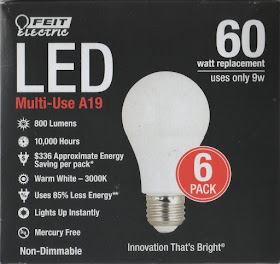Compare delivered illumination using my comparison test stand. The FEIT bulb illumination will be at stage left in photos. That of other bulbs proceeding left to right in this photo, will be at stage right.
At left FEIT 60w LED. At right 65 watt incandescent downlight about 2700°K. The downlight gives better illumination due to favorable directionality.
At left FEIT 60w LED. At right 65 watt incandescent downlight about 4000°K. The downlight gives better illumination due to favorable directionality.
At left FEIT 60w LED. At right "100 watt" GE Reveal halogen point source bulb using 72 watts, claimed 1120 lumens. Claimed 3000°K. The rather-directional LED bulb is brighter, though only claimed "60 w."
Attempt assignment of a Brightness number for the FEIT bulb, calling the FEIT brighter by 25%, 1.25*B4 = B5. A 100 watt incandescent is B4 by definition.
B5 (directional) is pretty good for a point-source LED. Know though that the FEIT bulb will be very dim vs. a "100w" incandescent where upright in a table lamp or sideways in a horizontal bulb holder over glass rectangle. The sideways brightness is surely not more than B2.5. Don't use the FEIT bulb except as downward-pointed from a ceiling or pendant, if you wish a reading light. It is NOT omnidirectional. See interior examination, photo further down in this post. And, if we want to read, we must stop wanting light bulbs.
Call both B5, and call the blue light ugly.
At left FEIT 60w LED. At right 13 watt CFL twist that needed a full minute to reach full (dim) brightness. A 13 watt CFL is rated about 450 lumens, and I assign it brightness B2. If the FEIT bulb is B5, it should be judged more than twice as illuminating in this photo. It is hard to tell. The comparison value is in matters of wall color correctness and the awful difficulty of startup. The CFL is perhaps 5000°K.
Assess FEIT bulb brightness by comparison with 671 lumens Nicor DLS4, 3000°K, 10 watts.

Again the FEIT 60w bulb is at stage left. The directional Nicor DLS4 at right is far more illuminating. I assign Brightness Number of directional 671 lumens as B4*671/450 = B6. Be generous, giving the bulb B5, as already proven brighter than a "100w" incandescent bulb.
The Nicor DLS4 gives much greater value, where one would want to conserve energy, in dimming.
I wanted to see the light engine of this bulb. So, I dropped it seven feet, ten times, to a hard floor. It wouldn't break! So I sectioned it with a hacksaw. The globe is about 0.070" thickness tough acrylic. The board is quite directional, but light is dispersed (and blocked) by the spherical, thick, acrylic.

I couldn't break the plastic shell, yet this bulb is dead. It will no longer engage A19 socket threads. The metal of the bulb threads is quite delicate, and every hit causes a cave-in. The bulb invariably whacks the floor and any hard object there, in the falling adventure.
Well, maybe not completely dead from the thread smashing. Crummy old bulb holders have loose threads. Where I could hold the socket with lots of torque, I managed to get this chopped light to fire up. The diodes are blindingly bright. Let's see if we can prove the poorer illumination where the bulb is perpendicular to the test screen.
Here again is comparison with Nicor DLS4, B6; FEIT bulb B5 stage left:
Turn the bulb 90°:
Here is comparison with Nicor DLS4, B6; sideways-illuminating FEIT bulb stage left. Call the FEIT LED brightness B2.4, matching sideways illumination from a 60-watt incandescent as designers may have ensured. B2.4 is that of a 60-watt incandescent bulb: B4*60/100 = B2.4. The FEIT LED bulb with this pitiful brightness saves 85% electricity. The Nicor DLS dimmed to B2.4 consumes 3.6 watts, saving 94% electricity. But, why should anyone want so little illumination? What we need is more light, from each luminaire position, at low cost.
Remember to check FEIT LED bulb brightness where not obstructed by the thick plastic bulb, here stage-left. Still Nicor DLS4 stage right.
The 800 lumens FEIT LED bulb is now B7, vs Nicor DLS4 B6. The thick plastic bulb blocks about a third of the issued light.
The FEIT LED bulb does not flicker at half power and less, on a good Cooper DAL06P dimmer. But some inefficiency causes lumens output to drop by much more than half. Don't try to dim the FEIT bulb. The package gave fair warning. This is not dimmable.
If we give up on light bulbs and throw away bulb holders, a better future is already on offer. Perhaps the need is of a reading lamp. Try this 5vdc light, USB-corded:
http://www.amazon.com/Lixada-Eyesight-ProtectionTable-Foldable-Dormitory/dp/B016EKBRVA
I can illuminate my keyboard very effectively at a fraction of a watt, from a USB port. Quite pretty, and durable. Folds up, out of the way, in good daylight. Think to assess brightness.
Of course, this does not light up a room. This is the light first touch-setting, five diodes 3000°K. The next setting gives blue light, ten diodes 5000°K.
The third setting fires all fifteen diodes, still kind of blue, but brighter, about B4, 99% power reduction vs. 100w bulb B4. (Here not as bright as Nicor B6.)























No comments:
Post a Comment